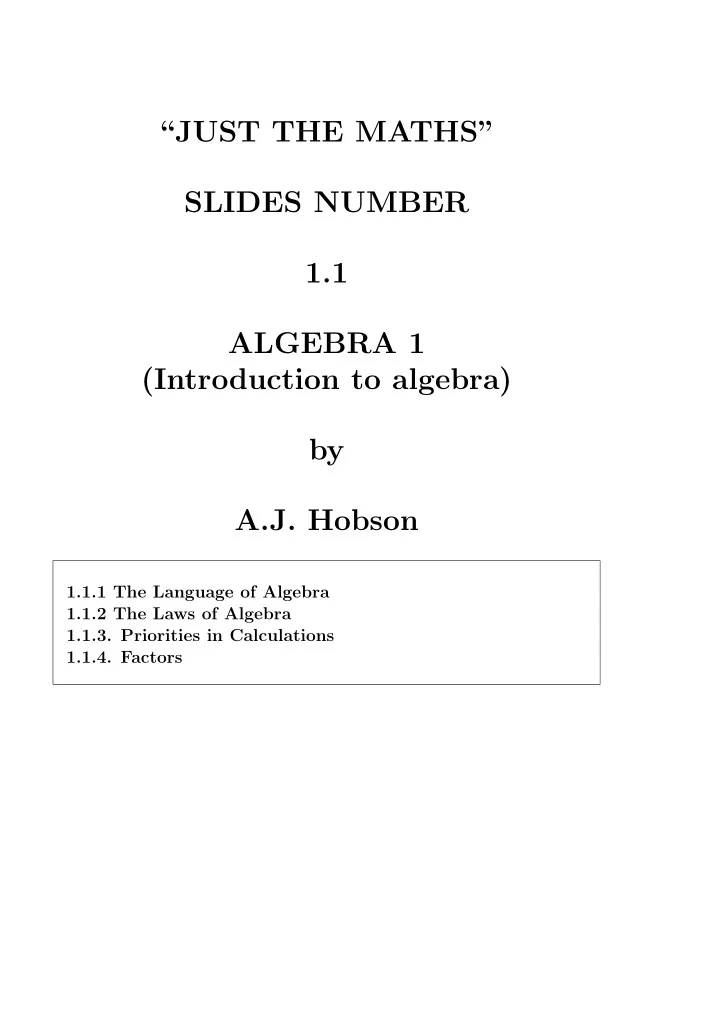

“JUST THE MATHS” SLIDES NUMBER 1.1 ALGEBRA 1 (Introduction to algebra) by A.J. Hobson 1.1.1 The Language of Algebra 1.1.2 The Laws of Algebra 1.1.3. Priorities in Calculations 1.1.4. Factors
UNIT 1.1 - ALGEBRA 1 INTRODUCTION TO ALGEBRA DEFINITION An “Algebra” uses Equality (=), Addition (+), Subtrac- tion (-), Multiplication ( × or .) and Division ( ÷ ). The Algebra of Numbers = “ARITHMETIC” 1.1.1 THE LANGUAGE OF ALGEBRA a , b and c denote constant numbers of arithmetic; x , y and z denote variable numbers of arithmetic (a) a + b is the “sum of a and b ”. a + a is written 2 a , a + a + a is written 3 a . (b) a − b is the “difference of a and b ”. (c) a × b , a.b , ab is the “product of a and b ”. a.a is written a 2 a.a.a is written a 3 − 1 × a is written − a and is the “negation” of a . (d) a ÷ b or a b is the “quotient” or “ratio” of a and b . (e) 1 a , [also written a − 1 ], is the “reciprocal” of a . 1
(f) | a | is the “modulus”, “absolute value” or “numerical value” of a . | a | = a when a is positive or zero; | a | = − a when a is negative or zero. Rules for combining fractions. 1. d = ad + bc a b + c bd 2. d = ad − bc a b − c bd 3. a b.c d = a.c b.d 4. a b ÷ c d = a b × d c = a.d b.c EXAMPLES 1. How much more than the difference of 127 and 59 is the sum of 127 and 59 ? Difference of 127 and 59 is 127 − 59 = 68. Sum of 127 and 59 is 127 + 59 = 186. Sum exceeds the difference by 186 − 68 = 118. 2
2. What is the reciprocal of the number which is 5 mul- tiplied by the difference of 8 and 2 ? Reciprocal of 5 . (8 − 2) = 1 30 . 3. Calculate the value of 4 2 3 − 5 1 9 expressing the answer as a fraction. 14 3 − 46 9 = 126 − 138 = − 12 27 = − 4 9 or 42 9 − 46 9 = − 4 27 9 4. Remove the modulus signs from the expression | a − 2 | in the cases when (i) a is greater than (or equal to) 2 and (ii) a is less than 2. (i) If a is greater than or equal to 2, | a − 2 | = a − 2 (ii) If a is less than 2, | a − 2 | = − ( a − 2) = 2 − a 1.1.2 THE LAWS OF ALGEBRA (a) The Commutative Law of Addition a + b = b + a (b) The Associative Law of Addition a + ( b + c ) = ( a + b ) + c (c) The Commutative Law of Multiplication a.b = b.a 3
(d) The Associative Law of Multipication a. ( b.c ) = ( a.b ) .c (e) The Distributive Laws a. ( b + c ) = a.b + a.c ( a + b ) .c = a.c + b.c Note for later: ( a + b ) . ( c + d ) = a.c + b.c + a.d + b.d 1.1.3 PRIORITIES IN CALCULATIONS Problem: 5 × 6 − 4 = 30 - 4 = 26 or 5 × 2 = 10 ???? B.O.D.M.A.S. B brackets ( ) First Priority O × of Joint Second Priority D division ÷ Joint Second Priority M multiplication × Joint Second Priority A addition + Joint Third Priority S subtraction - Joint Third Priority Exs. 5 × (6 − 4) = 5 × 2 = 10 5 × 6 − 4 = 30 − 4 = 26. 4
12 ÷ 3 − 1 = 4 − 1 = 3 12 ÷ (3 − 1) = 12 ÷ 2 = 6. 1.1.4 FACTORS If a number can be expressed as a product of other num- bers, each of those other numbers is called a “Factor” of the original number. EXAMPLES 1. 70 = 2 × 7 × 5 These are “prime” factors 2. Show that the numbers 78 and 182 have two common factors which are prime numbers. 78 = 2 × 3 × 13 182 = 2 × 7 × 13 Common factors are 2 and 13 - both prime. 5
Highest Common Factor, h.c.f. 90 = 2 × 3 × 3 × 5 and 108 = 2 × 2 × 3 × 3 × 3 h . c . f = 2 × 3 × 3 = 18 Lowest Common Multiple, l.c.m. 15 = 3 × 5 and 20 = 2 × 2 × 5 l . c . m . = 2 × 2 × 3 × 5 = 60 Lowest Terms Common factors may be cancelled to leave the fraction in its “lowest terms”. 15 3 × 5 × 7 = 1 3 × 5 105 = 7 6
Recommend
More recommend